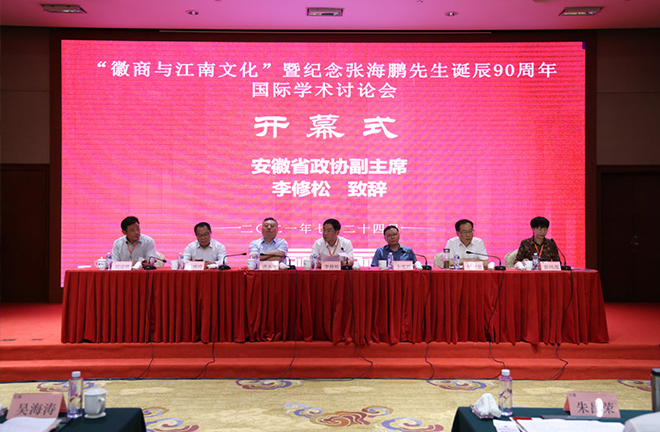Huizhou merchants key to interpreting Huizhou culture

A seminar on Huizhou merchants and Huizhou studies in Wuhu, Anhui Province, on July 24 Photo: AHNU
WUHU—An international seminar on Huizhou merchants and the Jiangnan culture centered in regions south of the Yangtze River was held to advance Huizhou studies, or Hui studies, in Wuhu, Anhui Province, on July 24.
Huizhou studies focus on Huizhou’s historical geography, traditional society, historical culture, and its legacy and innovation. Although Huizhou’s natural environment and culture have long been recorded and examined in Chinese history, Huizhou studies as a modern discipline was formed in the 1980s. In 1981, Zhang Haipeng, then deputy director of the Department of History at Anhui Normal University, shifted his research focus to Huizhou merchants. He actively built academic teams to lead Huizhou studies from fragmented to systematic research, promoting the gradual maturity of the discipline.
Ming and Qing Huizhou merchants
Huizhou merchants are a major topic in Huizhou studies. As Zhang pointed out, a certain economy breeds a certain culture, so the economic development of Huizhou also formed and developed a rather distinctive Huizhou culture. From a macro perspective, Huizhou merchants were the “yeast” of Huizhou culture.
“Business groups are representatives of local economic power,” said Chen Zhiping, director of the Guoxue Institute at Xiamen University. Research of business groups is conducive to probing regional economic history, political history, social history, and cultural history. At the same time, the business experience of representative Huizhou businessmen offers a point of reference for current entrepreneurs.
During the Ming (1368–1644) and Qing dynasties (1644–1911), the rise of Huizhou merchants and their huge economic achievements brought prosperity to the Jiangnan towns and helped the development of Jiangnan culture. According to Cho Young-hun, a professor from Korea University, from 1415 to 1784, Huizhou merchants actively participated in local social governance regarding the Grand Canal in the Huaiyang region [the lower reaches of the Huai and Yangtze rivers]. These activities help them transcend the labels of “external merchants” and “sojourners,” and establish the status of “settlers” and “local elites.”
“The great strides made in commerce and trade by Huizhou merchants in the Ming Dynasty unveiled China’s modern social transformation in the 16th century,” said Luan Chengxian, a research fellow from the Institute of Ancient History at the Chinese Academy of Social Sciences (CASS). Merchant groups represented by Huizhou merchants and Shanxi merchants were the actual leaders of social change and social transformation in the middle and late Ming era, and they were the pioneers of the “enlightenment movement” in the late Ming. As such, apart from their pivotal role in Huizhou studies, Huizhou merchants occupy a significant position when exploring social transformation in the Ming and Qing dynasties.
Ways forward
The boundary of Huizhou research is not merely limited to the ancient Huizhou area, specifically the Huizhou prefecture and the six counties under its jurisdiction in history. Its scope also contains the activities conducted by Huizhou merchants and the Huizhou people, therefore covering the whole country and even external locations around the world. Huizhou studies should expand to different fields and different spaces. It is necessary to extend Huizhou studies to the Jiangnan culture to expedite related disciplinary construction.
Bu Xianqun, director of the Institute of Ancient History at CASS, suggested Huizhou research be extended to the research level of the Jiangnan culture and Chinese regional culture. Over a long time span, regional culture is the foundation of a unified culture. Today’s regional culture, after continuous evolution in various historical periods, is subordinate yet not contrary to national identity. However, when it comes to analyzing relationships between regional culture and national identity, efforts should be made to investigate each historical stage from political, economic, social, ideological, and cultural aspects.
“Although recent decades have seen certain research results achieved in the field of Ming and Qing business groups, most focus is merely given to certain business groups, while the majority are still left out,” Chen added. Considering the major research topic of Ming and Qing business groups, scholars have yet to integrate individual research with overall research. Even in the study of individual business groups, there are still disputes on some important issues. Research of Ming and Qing business groups is still at the initial stage. Scholars need to do deeper research on individual business groups, and then a comprehensive study of the entire community.
Luan suggested highlighting “the perspective of macro-history” when reviewing the past. Proceeding from the perspective of macro-history, Ming and Qing Huizhou merchants should be examined under overall social changes. Huizhou merchants should be placed within the social evolution of the Ming and Qing era and even of ancient China. Taking a grand historical perspective to consider the historical role and status of Huizhou merchants in the Ming and Qing era, there remain multiple research topics, such as relationships between Huizhou merchants and the Ming and Qing market, relationships between the group and urban construction, as well as the trade of Huizhou merchants and the commercialization of industrial and agricultural product